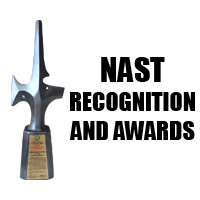The National Academy of Science and Technology, Philippines (NAST PHL), in collaboration with OCEANA, conducted a Science Policy and Information Forum (SPIF) on “Marine Spatial Planning and Coastal Reclamation: A Focus on Manila Bay Area” on 7 October 2020 via Zoom webinar.
NAST PHL Academician (Acd.) and President Rhodora V. Azanza officially opened the forum by highlighting the need for archipelagic countries such as the Philippines to devote on studies and make development plans based not only on land spatial planning but also on marine spatial planning. She expressed hope that the webinar would provide scientific information and guidance on matters concerning the country’s coastal and marine areas relevant to the sustainable management of these ecosystems which provide valuable goods and services. Acd. Mudjekeewis D. Santos, member of the Agricultural Sciences Division of NAST PHL, moderated the forum.
Insights on Marine Spatial Planning
Dr. Vera Horigue, research fellow at the Macquarie University, Sydney, Australia, presented marine spatial planning (MSP) as practiced in the Philippines. She discussed the importance of marine protected areas (MPAs) as a tool for MSP and their positive impacts on fisheries, coastline protection and biodiversity conservation, among others. Dr. Horigue also presented the concept of Systematic Conservation Planning (SCP), which pertains to decision making in marine spatial management.
Dr. Horigue ended her presentation with a few recommendations and areas of improvement in the management of areas like Manila Bay. Among these are: prioritization of the pelagic resources; availability, accessibility, and verification of data for MSP; and coordination of local government units to evaluate impacts of certain management decisions. She stated that the rehabilitation of Manila Bay requires collective and integrated efforts of municipal governments from Bataan to Cavite wherein rehabilitation, conservation and spatial planning would require looking at the bigger picture or considering the whole bay as one ecosystem.
Acd. Cesar L. Villanoy, member of the Mathematical and Physical Sciences Division of NAST PHL, presented his lecture on “Impacts of Pollution and Reclamation on the Physical Oceanography of Manila Bay”. According to him, the most important environmental problem in Manila Bay is pollution. He presented historical and comparative account of nutrient loading around the bay area, and their impacts on water movement and water residence time.
Furthermore, Acd. Villanoy showed that the bay is an estuary with a narrow mouth, the water generally coming in from the Cavite side and going out on the Bataan side. The bay could be negatively impacted by reclamation which include obstruction of littoral current, modification of wave propagation/energy dissipation patterns and modification of inland drainage system.
The next lecturer was Dr. Rene Rollon, Professor from the Institute of Environmental Science and Meteorology, University of the Philippines Diliman. He began his presentation by giving an overview of the ecological values of mangroves, which include: being the habitat for marine fisheries and wildlife; helping improve coastal water quality; protecting the coastline and coastal communities; and as blue carbon ecosystems.
Dr. Rollon shared their research works on the estimates of mangrove coverage in the country. In the case of Manila Bay area, of the 93,000 hectares original mangroves, 98% are estimated to have already been depleted. The areas that still have mangroves are mostly in Bataan and Pampanga where Key Biodiversity Areas (KBAs) have been designated by the Department of Environment and natural Resources (DENR). Several studies have targeted around 10% mangrove restoration but Dr. Rollon suggested that the targets should be higher to have considerable effects.
Dr. John McManus, from the National Center for Coral Reef Research at the University of Miami, presented his work on the effects of physical damages of dredging and reclamation to the marine environment/coral reefs and how they can be rehabilitated and managed. He emphasized the importance of the use of community organizing approach in coastal management, specifically the unity of stakeholders whilst making socially undesirable behavior unacceptable.
Presentations on: “Way Forward for Manila Bay”
National Economic Development Authority (NEDA) Assistant Secretary Roderick M. Planta, and Prof. Rex Victor O. Cruz of the University of the Philippines Los Baños (UPLB) Foundation (as Vice Project leader) presented the draft “Manila Bay Sustainable Development Plan”. An overview of the project which includes an “Integrated Coastal Zone Management” (ICZM) Framework, was shown. The representatives from NEDA assured that they did consultations with various stakeholders that include the Ecosystems Research and Development Bureau (ERDB) and the Bureau of Fisheries and Aquatic Resources (BFAR).
Director Ricardo L. Calderon of the Biodiversity Management Bureau of the Department of Environment and Natural Resources Biodiversity Management Bureau (DENR-BMB) stated that Manila Bay cleanups would not be possible without cleaning its river systems. He also suggested the formation of a single management authority for Manila Bay in-charge of proper monitoring and ownership of the responsibility and accountability. He also suggested having another advisory body for Manila Bay separate from the advisory body created by the Supreme Court Mandamus.
The recommendations of the Philippine Coast Guard, as represented by Captain Xerxes Proceso B. Fernandez, are the mapping of critical habitats as well as the fisheries and mariculture areas while ensuring that these, including the reclamations would not affect water circulation within the bay, river drainage, and vessel movement and safety.
Speaking for the private sector, Atty. Gloria Estenzo Ramos of OCEANA Philippines, identified the major challenges in Manila Bay, which are weak fisheries management and unabated reclamation. She emphasized the need for full compliance with laws and regulations, as well as science-based participatory and transparent management processes and integration of the impacts of climate change.
The panelists’ discussion was capped by the talk of Dr. Nilo S. Katada from the Bureau of Fisheries and Aquatic Resources (BFAR). Their suggestions for ways forward for the Manila bay include the updating of fisherfolk and boat registrations, the consistent inventory of aquafarms, assisting and organizing coastal clean-ups, and implementing closed fishing season for different types of fishes.
To officially close the forum, National Scientist (NS) Angel Alcala, pioneering marine scientist on Marine Protected Areas, showed recorded reclamation impacts on some coastlines in the United States and in Southern Philippines, particularly in Dumaguete. He thanked all the speakers for their insightful presentations and suggestions on the topic of coastal reclamation and marine spatial planning. He also encouraged transparency in the process of decision making in the management of the environment. (Jainor Timothy U. Garcia/NAST PHL)
NAST PHL is an attached agency to the Department of Science and Technology (DOST) and serves as the country’s premier recognition and advisory body on matters related to science and technology











